How to Create the Perfect Pitch Deck: Be Prepared for Investors!
In the business world, there are many ways an organization can reach out to investors, clients, and potential partners. Popular methods include face-to-face meetings, video calls, and business tours.
The main goal of these interactions is to give your potential allies a clear vision of your company and provide them with a valid reason to invest their time and money in your project. However, what could be easier than showing the value of your project visually?
That’s why it’s important to learn how to create a pitch deck that stays top of mind with potential partners. Keep in mind that a well-crafted pitch deck could open new doors for your business and accelerate its success.
Here are the topics you’ll explore today:
- What is a Pitch Deck?
- Planning Stage: How to Build a Pitch Deck?
- Design Stage: What Slides Should Be in a Pitch Deck?
- Presentation Tips for Pitching to Investors
- Let the Experts Handle Your Pitch Deck Design!
Let’s start!
What is a Pitch Deck?
A pitch deck is a presentation designed to highlight your business’s unique value and capture the attention of potential partners, investors, or other stakeholders interested in your project.
Think of pitch deck presentations as your business cards for key stakeholders. Usually, this presentation will help you secure another meeting with potential investors.
Pitch presentations typically consist of 10 to 15 slides since investors review multiple documents every day. So, if you want to stand out, you need to be clear and strategic with the information you share.

Planning Stage: How to Build a Pitch Deck?
Creating a pitch deck from scratch without a clear understanding of your target audience and purpose may lead to your presentation being ignored or overlooked.
Here are a few key aspects to consider:
Your Target Audience
This is probably the most important factor and deserves your full attention. Understanding your target audience will ensure that your pitch deck is delivered in the right manner and style, allowing your message to be successfully conveyed.
Creating a generic pitch deck that you can use in multiple meetings could result in negative feedback and a mixed message to your potential partners.
Here are some guiding questions:
- What is their primary language?
- What communication style do they prefer?
- Do they understand your business or industry?
- Will they understand technical terminology?
- Based on your audience’s profile, should you focus more on the problem or the solution when presenting?
Answering these questions will ensure that your pitch deck presentation is tailored to your actual audience, maximizing its impact.
For example, if you create a pitch deck with heavy technical terminology for an investor who isn’t familiar with your business, you risk causing confusion and losing his attention.
Your Purpose
Once you’ve analyzed your target audience, you’ll need to consider your purpose so you can prioritize certain topics.
Take a moment to ask yourself: What do you hope to achieve with your pitch deck presentation?
Here are some ideas:
- Secure a second meeting with an investor.
- Get selected for an incubation or acceleration program.
- Establish a collaboration with a potential partner.
- Get a customer to place an order or create an account.
As you can see, this planning stage will greatly improve the viability and effectiveness of your slides.
We also recommend asking for feedback from different departments or teammates to perfect every detail of your pitch presentation.
Now, let’s dive into the design of a perfect pitch deck!
Design Stage: What Slides Should Be in a Pitch Deck?
By now, you should have a solid plan and be fully aware of the direction you want to take with your pitch deck presentation.
It’s time to create your pitch deck structure from scratch!
Slide 1 - Introduction and One-liner
The introduction slide is one of the most important, as it often determines the level of attention your audience will give you.
The one-liner, also known as a hook or slogan, is often used on this first slide as it summarizes your project as concisely as possible. There are no strict rules for creating a one-liner, but it must definitely spark an emotion in your audience: curiosity.
Another option is to create a story that humanizes your project. It’s up to you how you want to present it and connect it to the next slide.

Slide 2 - The Problem
Behind every great startup is a great problem. Naturally, in order to address it, you must conduct deep research to identify an underserved niche in the market.
On this slide, you should explain how this problem affects a specific segment of the population. Adding examples or data will help support your problem statement.
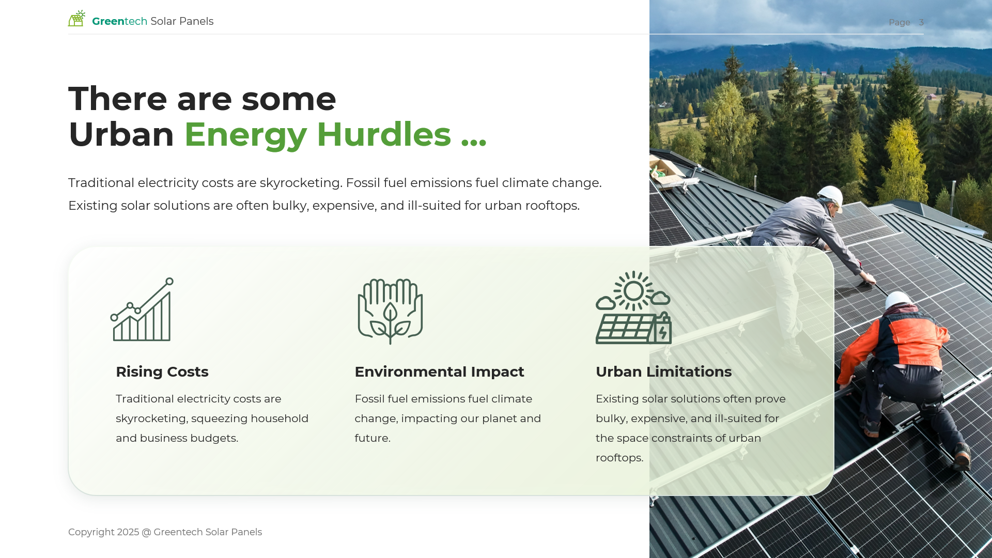
Slide 3 - The Solution
The solution is the heart of your pitch deck presentation. On this slide, you need all your persuasive skills to convince your audience that your solution is the winning option.
We recommend creating a compelling narrative that connects this slide with the previous one, conveying a sense of urgency.
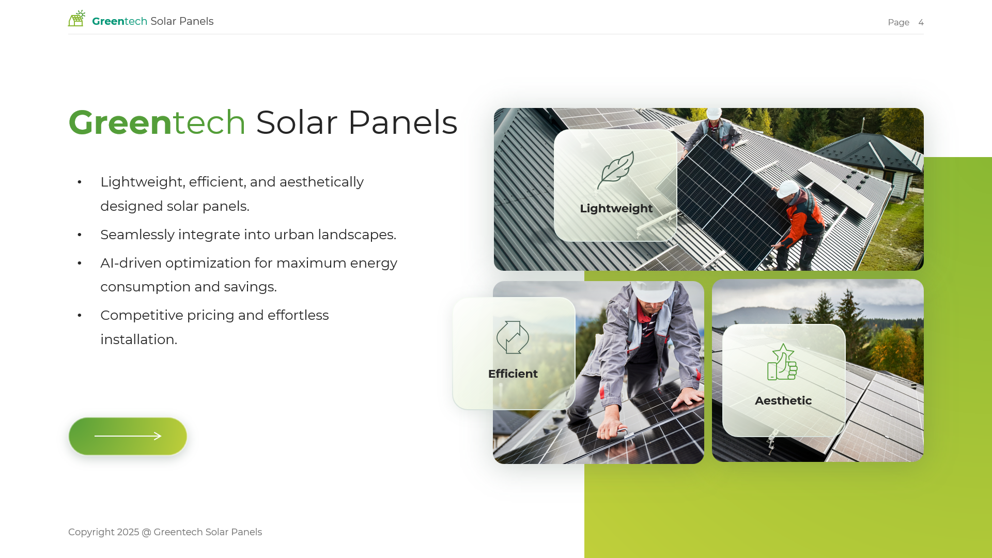
Slide 4 - The Product or Service
On this slide, you can go deeper into the features of your product or service, highlighting what makes it unique compared to your competitors.
If your product or service is complex, you can add a slide explaining how it works step by step.
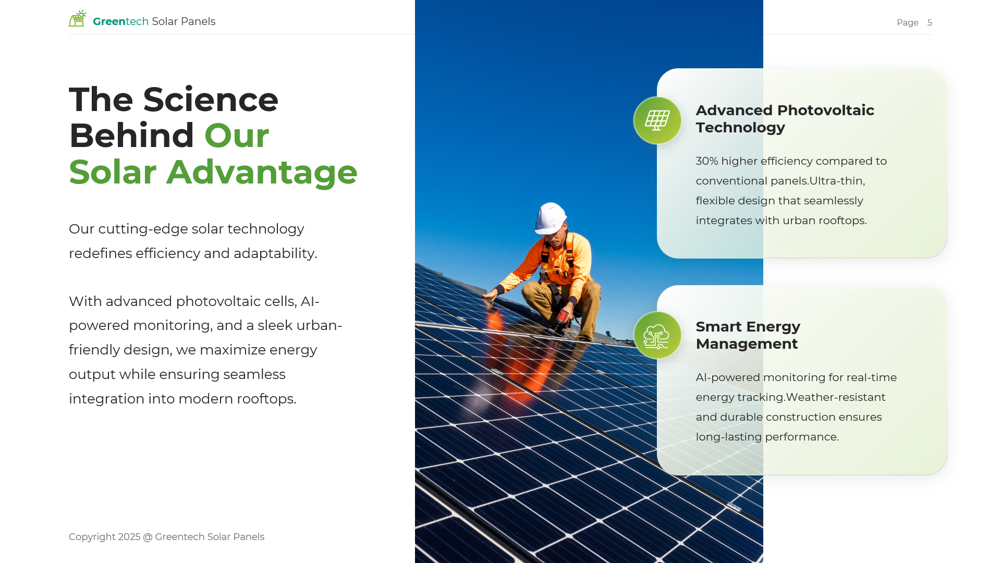
Slide 5 - Market Size and Market Fit
The success of a startup depends on the market size. Therefore, this slide is crucial for demonstrating that your market niche is valuable or has growth potential.
The last point is closely related to the “momentum,” which answers the question: Why is this the right time to solve this problem?
In this section, three types of estimates are commonly used: TAM, SAM, and SOM.
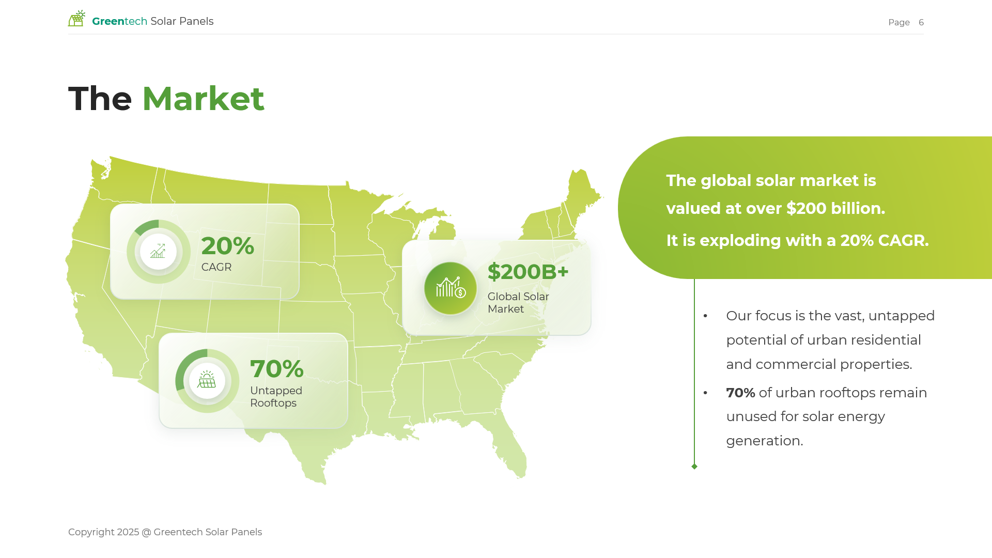
Slide 6 - Business Model
Freemium or membership model? On this slide of your pitch deck, you should describe the business model you’ve chosen for your project.
Some popular business models are:
- Business to Business (B2B)
- Business to Customer (B2C)
- Direct to Customer (D2C)
- Customer to Customer (C2C)
- Software as a Service (SaaS)
- Freemium
- Marketplace
- Franchise
- Black Kitchen
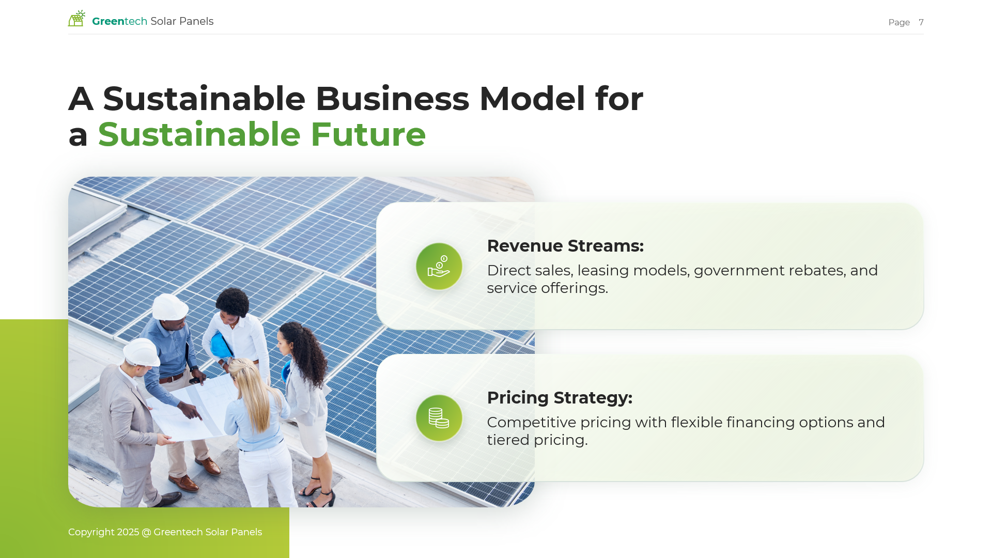
Slide 7 - Traction and Revenue
If you already have sales, don’t hesitate to include a graph showing your revenue. This is a clear sign that your solution works and is crucial to show it to potential investors.
Remember, there are multiple ways to showcase traction to investors. If your project is still new to the market, here are some ideas to highlight your progress:
- User growth
- App downloads and retention
- Reviews in the App Store
- SEO ranking of your website
- Customer Acquisition Cost (CAC)
- Lifetime Value (LTV)
- Partnerships or key customers acquired
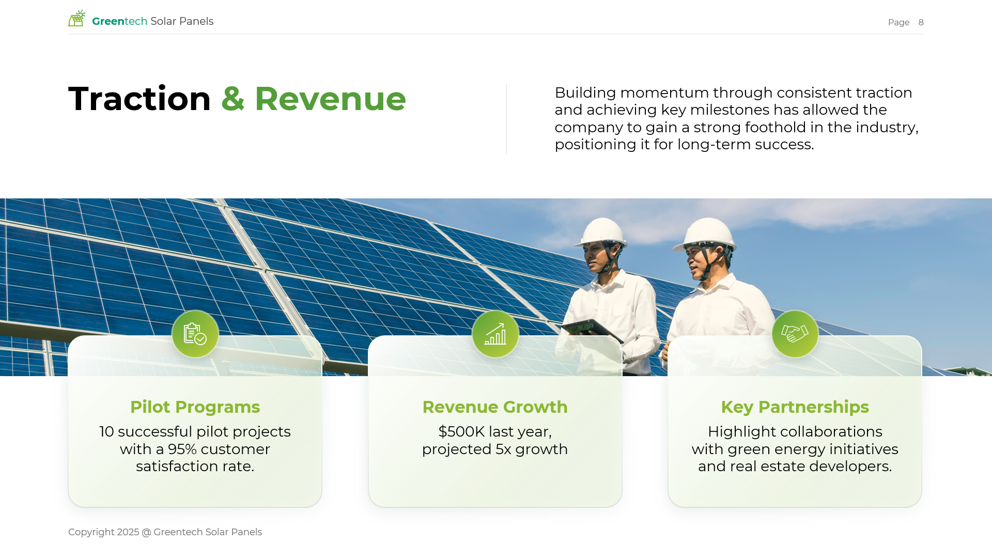
Slide 8 - Go-to-Market Strategy
This slide should describe your strategy for acquiring customers, including marketing, sales, and distribution tactics.
Ideally, you should be specific with the information you add to this slide, as it will give the impression that you have a clear action plan.
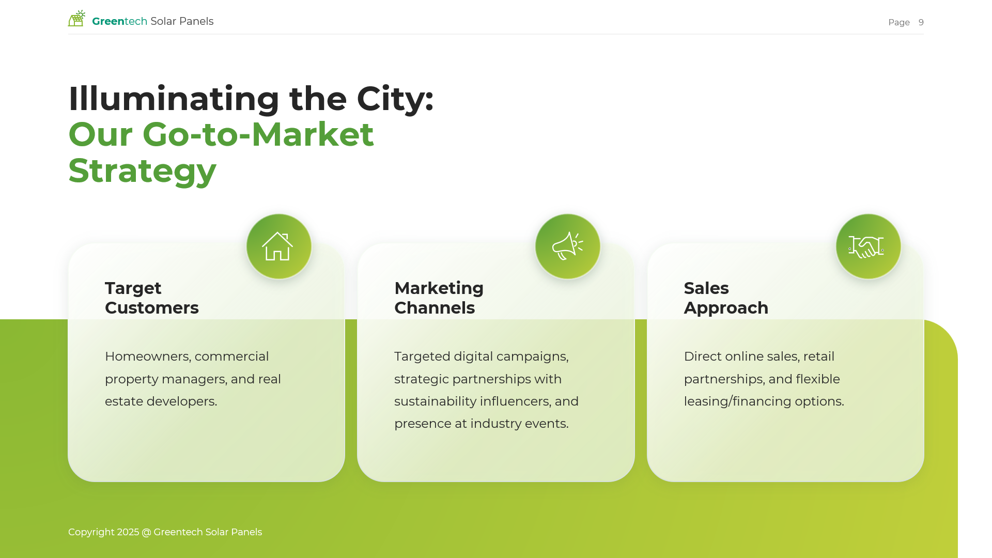
Slide 9 - The Competition
Another important part of this process is understanding your competition. Even if your proposal is innovative, there will always be a substitute product that meets your target’s current needs.
You can present your competition in various ways, but one helpful graphic is the competition matrix. We recommend selecting the most important variables and organizing them by priority (see below).
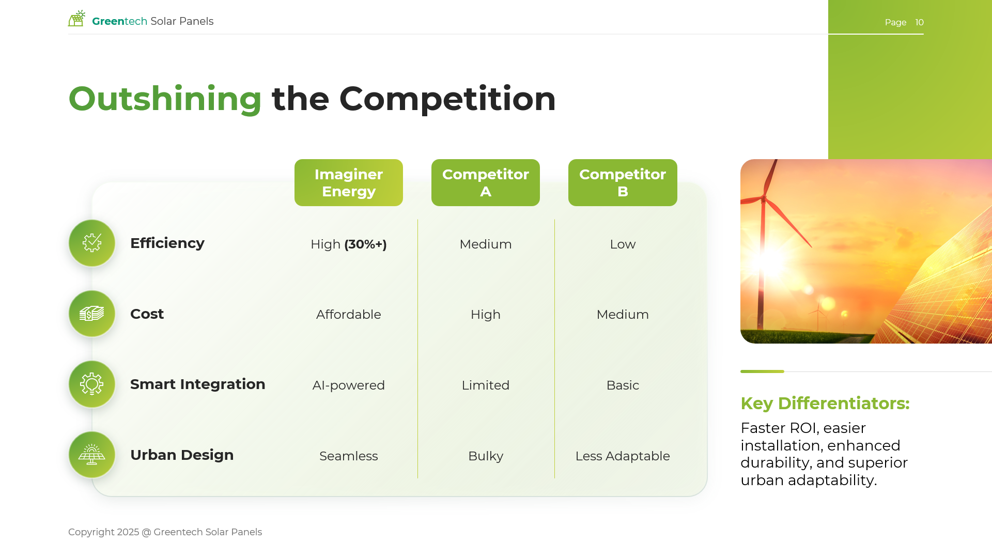
Slide 10 - The Team
Use this slide to highlight your team’s skills and achievements during your pitch deck presentation.
You must show them why you are the right people to execute the solution and tackle any challenges along the way.
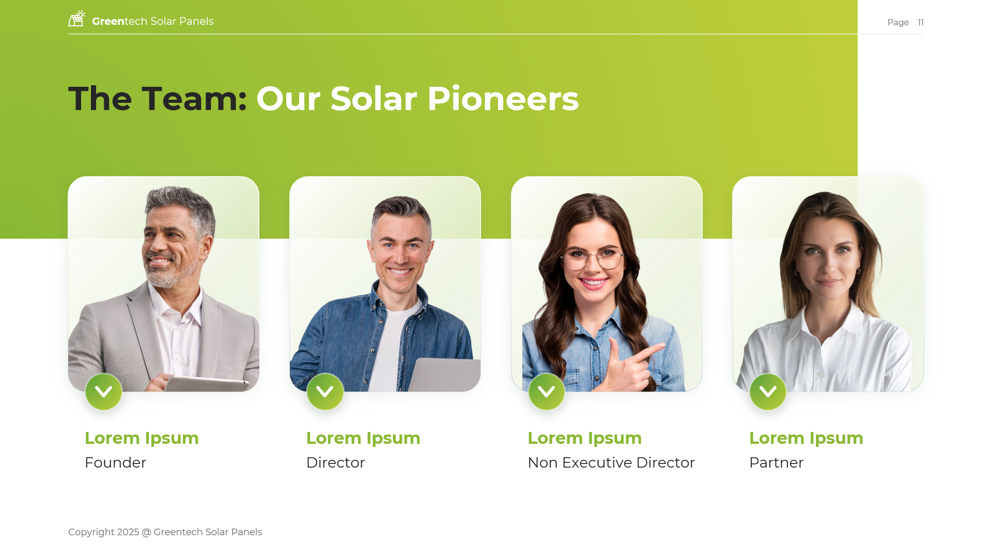
Slide 11 - Fundraising (The Deal)
In this section of your pitch deck structure, specify how much capital you’re seeking and what your priorities are.
It’s also key to highlight the opportunity for investors, including your startup’s valuation, the type of investment (equity, convertible note, etc.), and expected returns.
Remember to be realistic with the amount requested and demonstrate how this investment will drive the growth of your startup.
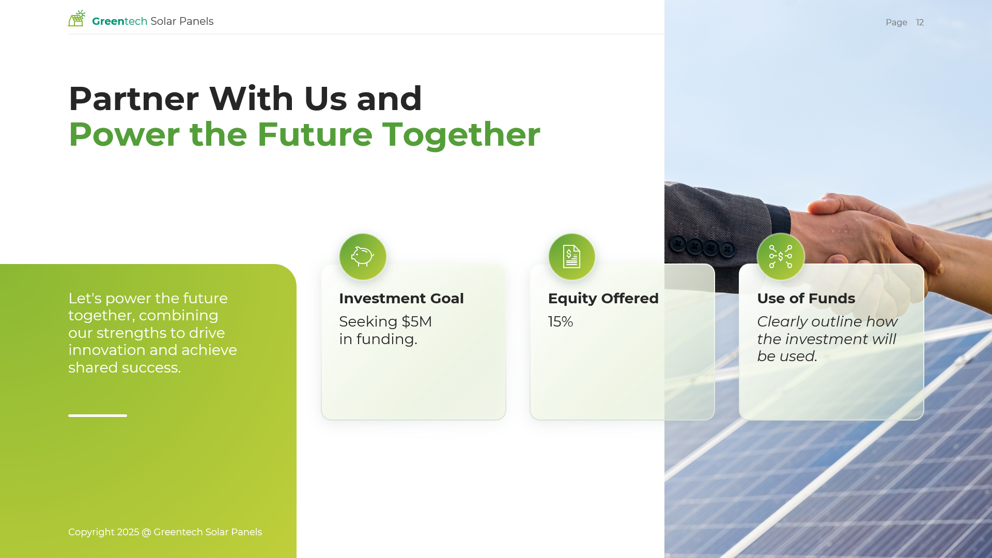
Slide 12 - Closure
A perfect pitch deck ends with an outstanding closure. A great option here is to provide a brief summary and finish with a clear call to action.
It’s also ideal to include your contact details so your potential allies can stay in touch.

Presentation Tips for Pitching to Investors
Creating an effective and engaging pitch deck is like composing a symphony: there are essential notes to hit and others you’ll want to avoid to keep the harmony.
Part of the process is striking a balance between aesthetics and functionality, ensuring your presentation is visually captivating at first glance while also delivering the essential information to keep potential investors engaged.
Here is our list of do’s and don’ts for creating the perfect pitch deck:
DO’s when presenting a Pitch Deck
- Evoke emotions through a story: An emotional pitch deck will resonate more deeply with your audience. Anecdotes, for example, can be a great resource for creating empathy.
- Promote one idea per slide: Adding more than one idea per slide can cause confusion and contradictory messages.
- Maintain consistency: Your brand identity should be visible in every slide, including visual elements like your logo or color palette, as well as your brand’s communication tone.
- Correct errors: There’s nothing more unprofessional than a presentation filled with grammatical errors or disorganized content. Check your final pitch presentation before the final day.
DON’Ts when presenting a Pitch Deck
- Add too much information on a single slide: While lists can be helpful, too many bullet points can be counterproductive. Less is more!
- Make it too long: 15 slides should be the maximum; anything longer could impact your audience’s attention.
- Use only text: Images, charts, and videos should also be included in your pitch deck.
- Use only images: On the other hand, not using text could lead to a lack of understanding.
- Use small fonts: All the content you present should be clear and easy to read.
- Just read during the presentation: This advice applies to all types of presentations; your slides are a visual aid, so the most relevant information should be explained orally.
Let the Experts Handle Your Pitch Deck Design!
As you can see, learning how to make a pitch deck is an art that requires thorough research and attention to detail.
If you want your slides to stand out among the thousands of pitch decks seen daily, we at 24Slides can help elevate your efforts.
We’ve been in the creative market for over 10 years and specialize in designing impactful PowerPoint and Google Slides presentations. Our customers worldwide support the quality of our service.
Contact our team and get your pitch deck presentation the very next day!
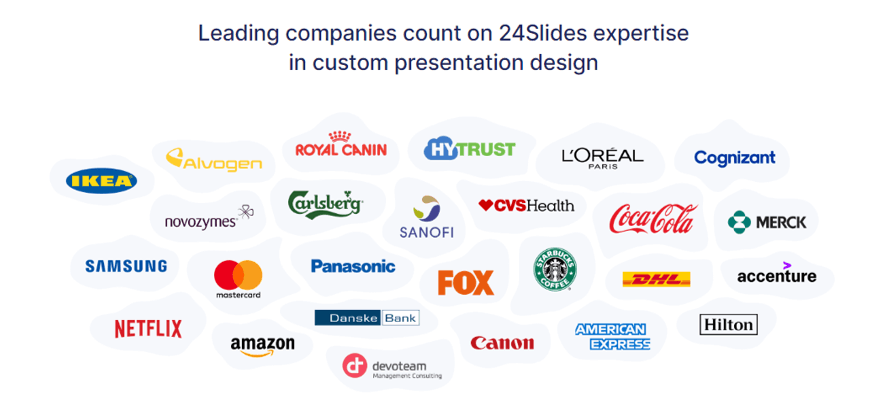
If you like this content, you might also be interested in:




